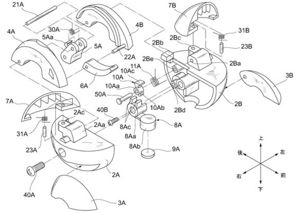History of Bakugan
Bakugan as a physical toy was first envisioned by American inventor Aldric Saucier, and was picked up by Spin Master and Sega Toys.[1]
Contents
Creation[edit]
The first idea for Bakugan was created when Aldric Saucier, an American inventor, was walking through the toy aisle at Wal-Mart. He was thinking about doing something with small action figures when he noticed marbles, and came up with the idea for small figures inside of marbles. He scribbled his idea on top a napkin, and created the first incarnation of the Bakugan toy.[2]

He then submitted it to Spin Master with the help of Sheldon Goldberg, his inventor representative.
Discovery by Spin Master[edit]
Ben Varadi and Ben Dermer, executives for Spin Master, were trying to figure out a "marble of the twenty-first century". They were shown Saucier's idea for a marble and accepted it.
Spin Master then took the idea and created prototypes. However, they were not content with the current form of the product, so they sent it to Japan, to Sega Toys. Sega created the system for the Bakugan game, including the cards, points, and battling.

Television[edit]
From there, executives at Spin Master also saw potential for a television series. Ronnen Harary, co-founder and co-CEO of Spin Master, contacted Isao Kokubun, the president of Sega Toys. Kokubun offered to pay for half the cost of the television show, or about $6 million. The original 52 episode season grew into 189 half-hour episodes of Bakugan.
Launch[edit]
Bakugan first launched in Canada, using the country as a test market. It was received very well, and Spin Master moved forwards towards launching in other places around the world. From there, Bakugan became a success, selling extremely well during its first three years. At one point, the toys were outselling Star Wars and Transformers.
Lifelong revenue and impact[edit]
Over the course of its lifespan, Bakugan generated well over a billion dollars in toy sales, and a couple hundred million dollars of merchandizing and related sales. It was Property of the Year in 2009. [3]